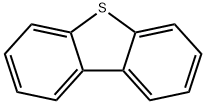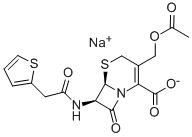Dibenzothiophene , 98% , 132-65-0
Synonym(s):
DBT;Dibenzothiophene;Diphenylene sulfide
CAS NO.:132-65-0
Empirical Formula: C12H8S
Molecular Weight: 184.26
MDL number: MFCD00004969
EINECS: 205-072-9
| Pack Size | Price | Stock | Quantity |
| 5G | RMB24.00 | In Stock |
|
| 25G | RMB50.40 | In Stock |
|
| 100G | RMB165.60 | In Stock |
|
| 500G | RMB692.80 | In Stock |
|
| others | Enquire |
PRODUCT Properties
| Melting point: | 97-100 °C (lit.) |
| Boiling point: | 332-333 °C (lit.) |
| Density | 1.1410 (rough estimate) |
| refractive index | 1.6500 (estimate) |
| Flash point: | 170 °C |
| storage temp. | Store below +30°C. |
| solubility | 0.0015g/l (Lit.) |
| form | Crystalline Powder and/or Chunks |
| color | white |
| PH | 7 (50g/l, H2O, 20℃)(slurry) |
| Water Solubility | SOLUBLE |
| BRN | 121101 |
| LogP | 4.380 |
| CAS DataBase Reference | 132-65-0(CAS DataBase Reference) |
| NIST Chemistry Reference | Dibenzothiophene(132-65-0) |
| IARC | 3 (Vol. 103) 2013 |
| EPA Substance Registry System | Dibenzothiophene (132-65-0) |
Description and Uses
Dibenzothiophene (DBT) is an organosulfur compound found in crude oil and petroleum. It is a colourless solid that is chemically somewhat similar to anthracene. Dibenzothiophene is used as a chemical intermediate in cosmetics and pharmaceuticals (NLM, 2006).It is used to investigate the effect of sulfur compounds in gasoline range during the fluid catalytic cracking (FCC) process.
Dibenzothiophene is used to investigate the effect of sulfur compounds in the gasoline range during the fluid catalytic cracking (FCC) process. It can also be used as:
A starting material for the synthesis of corresponding sulfoxide and sulfone by oxidative desulfurization using various catalysts.
A template for the synthesis of surface molecular imprinted polymer (SMIP). SMIP is applicable for the removal of dibenzothiophene during desulfurization of the gasoline.
A precursor for the synthesis of DBT based π-conjugating polymers.
Safety
| Symbol(GHS) |   GHS07,GHS09 |
| Signal word | Warning |
| Hazard statements | H302-H410 |
| Precautionary statements | P273-P301+P312+P330 |
| Hazard Codes | Xn,N |
| Risk Statements | 22-20/21/22-50/53 |
| Safety Statements | 36-61-60 |
| RIDADR | 2811 |
| WGK Germany | 3 |
| RTECS | HQ3490550 |
| Autoignition Temperature | >450 °C |
| TSCA | Yes |
| HazardClass | 9 |
| PackingGroup | III |
| HS Code | 29349990 |
| Hazardous Substances Data | 132-65-0(Hazardous Substances Data) |
| Toxicity | mouse,LD,intraperitoneal,> 500mg/kg (500mg/kg),"Summary Tables of Biological Tests," National Research Council Chemical-Biological Coordination Center. Vol. 4, Pg. 378, 1952. |





